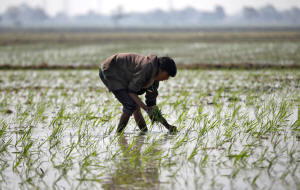How El Nino threatens emerging market economies
 Send a link to a friend
Send a link to a friend
 August 04, 2023]
By Jorgelina do Rosario and Libby George August 04, 2023]
By Jorgelina do Rosario and Libby George
LONDON (Reuters) - Countries around the world are battling heatwaves and
floods fuelled by El Nino, a naturally occurring climate phenomenon that
has a 90% probability of persisting in the second half of 2023,
according to the World Meteorological Organization.
The worldwide impact can be enormous, but the stakes are higher for
emerging markets, which are more exposed to swings in food and energy
prices and production and often have smaller fiscal buffers that limit
their ability to cushion the impact.
Below are five charts showing the impact El Nino - when waters in the
central and eastern Pacific are warmer than usual - could have on key
emerging markets.
1/MOST VULNERABLE
India and Egypt are among the economies that are overall most vulnerable
to El Nino's impact this year, according to an index by Standard
Chartered Bank, taking into account the weight of the primary sector,
the share of food in inflation baskets and a country's ability to offset
through fiscal support.

Ghana, Kenya and the Philippines are also high up on the list while
countries such as South Africa and Chile are among the least vulnerable
- together with most of the developed market economies such as Germany
or the United States.
"We believe that the countries most at risk from an El Nino event this
year are those that have relatively weak economic fundamentals and that
experienced relatively weak agricultural production during the 2014-16
El Nino period," said Eugene Klerk, head of ESG Research at Standard
Chartered Bank.
2/AGRICULTURAL PRESSURES
Sudden changes in rainfall or temperature can wreak havoc on crops. With
agriculture accounting for a larger share of the economy and employment
in Africa and South Asia than elsewhere, these regions are especially
vulnerable to the El Nino fallout.
"A sharp reduction in the volume of crops that can be exported could
result in balance of payments strains for some economies," according to
a research note led by Jennifer McKeown, chief global economist for
Capital Economics.
India has banned exports of a key variety of rice, cutting overall
supplies to world markets by a fifth. Nearly 90% of rice is produced in
Asia, and threatened by dry El Nino weather, with the Philippines and
Thailand also at risk. Other produce in focus includes cocoa from Ivory
Coast and Ghana, sugar from India and Thailand and coffee from Vietnam
and Indonesia.
There are, however, exceptions - Argentina had a record soy harvest in
previous El Nino episodes, according to Morgan Stanley.
"El Nino tends to be negative in EM, though Argentina is an exception,"
the bank's Fernando Sedano wrote in a note, adding "Argentina is likely
the only net winner of El Nino."

[to top of second column]
|

A farmer plants saplings in a paddy
field on the outskirts of Ahmedabad, India, January 31, 2020.
Picture taken January 31, 2020. REUTERS/Amit Dave/File Photo

3/FRAGILE FOOD
Food prices make up a larger share of the CPI baskets of emerging
markets - as much as 40% in many low income economies - so El Nino's
severity is set to directly impact inflation.
A European Central Bank analysis suggests that a one-degree
temperature increase during El Nino historically has raised global
food prices by more than 6% after one year.
Southern Africa, Central America and the Caribbean and parts of Asia
are of "particular concern" due to already high levels of food
insecurity, according to the Food and Agriculture Organization of
the United Nations(FAO).
David Rees, senior emerging markets economist at Schroders, warned
that a strong El Nino could push emerging market food inflation back
into double digits in 2024.
4/A HYDRO QUESTION
Significant changes to rainfall, or prolonged droughts, could also
impact hydropower output and boost gas and coal prices as a result,
according to Capital Economics.
"Several countries, mostly in Africa, are heavily reliant on
hydroelectricity," the note said. "Lower rainfall could hinder
electricity generation and possibly lead to power rationing."
Energy prices are also a key driver of food inflation, they warned,
while warmer temperatures could increase demand for air
conditioning.

5/CLOUDING THE INFLATION PICTURE
Latin American central banks were among the first to ramp up
interest rates after COVID-19 to fight rising prices, and are the
first to kick off easing, led by Chile and Brazil.
But the El Nino impact on agricultural production and electricity
generation could complicate disinflation, and lead to
higher-for-longer rates.
"Colombia and Peru are the most exposed countries, followed by Chile
and Brazil to a lesser extent," said BofA's Latam local market
strategist Antonio Gabriel.
BofA estimates that El Nino would be "at least of moderate intensity
this year", but severe intensity could raise inflation by up to 2.5%
in Colombia and 1.5% in Peru.
"Mexico seems mostly isolated," Gabriel added.
(Reporting by Jorgelina do Rosario and Libby George, editing by
Karin Strohecker, Kirsten Donovan)
[© 2023 Thomson Reuters. All rights
reserved.]This material may not be published,
broadcast, rewritten or redistributed.
Thompson Reuters is solely responsible for this content. |